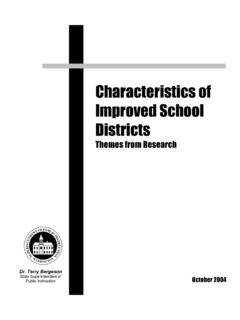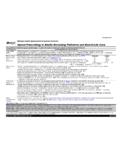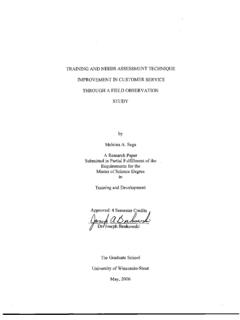Transcription of INTERNAL REVENUE SERVICE NATIONAL OFFICE …
1 INTERNAL REVENUE SERVICENATIONAL OFFICE TECHNICAL ADVICE MEMORANDUMM arch 15, 2010 Third Party Communication: NoneDate of Communication: Not ApplicableNumber: 201027045 Release Date: 7/9/2010 Index (UIL) No. , No.:TAM-127287-09 Director-------------------------------- ---------------------------------------- Taxpayer's Name:----------------------------------- -------------------Taxpayer's Address:-------------------------------- ------------------------------Taxpayer's Identification No----------------Year(s) Involved:------------------------------- --------Date of Conference:--------------------------LEG END:Taxpayer---------------------------- -------------------------- A----B----ISSUE(S) the Taxpayer s transfers of retail buildings in Ground Owned transactions and in Ground Leased transactions qualify as sales under 1001 of the INTERNAL REVENUE Code so that Taxpayer recognizes gain or the Taxpayer held certain retail buildings primarily for sale to customers in the ordinary course of its trade or business under 1221(a)(1) so that sale of the retail buildings resulted in ordinary, not capital, gain or loss.
2 CONCLUSION(S) Taxpayer s transfers of retail buildings in Ground Owned transactions qualify as sales under 1001 and result in gain or loss. The Taxpayer s transfers of TAM-127287-092retail buildings in Ground Leased transactions do not qualify as sales. Instead, the tenant improvement allowances received by Taxpayer from landlords in these transactions represent reimbursements for costs incurred by Taxpayer for leasehold improvements to be owned by the landlords. To the extent Taxpayer has incurred costs that exceed the tenant improvement allowance received from a landlord for a particular retail building, Taxpayer has a depreciable interest in the retail held the retail buildings sold in Ground Owned transactions primarily for sale to customers in the ordinary course of its trade or business under 1221(a)(1), and the sale of these retail buildings resulted in ordinary, not capital, gain or :Taxpayer is a specialty retailer of consumer electronics, home OFFICE products, entertainment software and related services .
3 Taxpayer operates retail stores throughout the United States. The majority of Taxpayer's retail stores are self-constructed in either a Ground Owned or Ground Leased transaction. Four representative transactions were submitted to the NATIONAL OFFICE for review. Three transactions are Ground Leased transactions and one is a Ground Owned transaction. Ground Owned TransactionsIn a Ground Owned transaction, Taxpayer owns the land upon which it constructs a building. Following construction and an appraisal, Taxpayer transfers title to the land and the building to an institutional investor for cash consideration. Taxpayer then leases back the property, generally for a term of 22 years, with two ten-year renewal periods at Taxpayer s option. Rent for the renewal terms is pre-determined and substantial. Ground Leased TransactionsIn a Ground Leased transaction, Taxpayer leases land from a landlord (typically a shopping center developer) and constructs a building to be used by Taxpayer as a retail store ( the leasehold improvement or retail building ).
4 Upon completion of the leasehold improvement , the landlord is obligated to pay Taxpayer a tenant improvement Allowance ("TIA"). Following construction of the leasehold improvements, the landlord leases the land and leasehold improvements to Taxpayer for a term substantially similar to those common under the Ground Owned amount of the TIA is negotiated by Taxpayer and the landlord prior to construction of the leasehold improvement . While the amounts paid Taxpayer in Ground Owned transactions were based on independent third-party appraisals, no appraisals were TAM-127287-093performed as part of the Ground Leased transactions. Rather, the amount of the TIA in these transactions reflected the relative bargaining strengths of Taxpayer and its landlord, with the projected cost of leasehold improvements providing a starting point for negotiation. The TIA generally is paid to Taxpayer after the leasehold improvements are constructed, title to the improvements is transferred to the landlord, and the Taxpayer provides proof that all contractors have been paid.
5 If a landlord fails to pay any portion of the TIA, the lease agreement permits Taxpayer to withhold or reduce rent until the full amount of the TIA is paid. Generally, the amount of the TIA in Ground Leased transactions is less than the amount expended by Taxpayer to construct the leasehold improvements. LAW AND ANALYSIS:Issue OneWhether the Taxpayer s transfers of retail buildings in Ground Ownedtransactions and in Ground Leased transactions qualify as sales under 1001 so that Taxpayer recognizes gain or loss. Ground Owned TransactionsIn the case of Ground Owned transactions, Examination s position is that the sale-leaseback transactions are in substance financings, not sales, because the term of the leaseback to Taxpayer exceeds the useful life of the property. In applying the doctrine of substance over form, courts look to the objective economic realities of a transaction rather than to the particular form the parties may have employed.
6 Frank Lyon Co. v. United States, 435 561, 573 (1978). Within the field of taxation, the courts are concerned with "substance and realities, and formal written documents are not rigidly binding. Helvering v. Lazarus & Co., 308 252, 255 (1939). A lease agreement that transfers all of the benefits of ownership of personal property to the lessee for substantially the entire useful life of the property is considered a sale ( , the transfer of equitable ownership). See, , Rev. Rul. 55-540, 1955-2 39; Rev. Rul. 55-541, 1955-2 19. Where the transaction involves a sale-leaseback, support exists for recharacterizing the transaction as a financing. See, , Rev. Rul. 72-543, 1972-2 87 (transfer of title to a vessel followed by 21-year charter back to seller for rent sufficient to repay acquisition and reconstruction costs plus accrued interest recharacterized as a financing arrangement.)TAM-127287-094 Where real property is subject to a sale and leaseback, courts have sometimes recast the transaction as a financing arrangement.
7 However, in such cases, a comparison of the length of the lease term to the estimated useful life of the real property is only one of a number of factors considered in making the determination of whether or not to respect the form of the transaction. See, , Helvering v. Lazarus, supra(Court recharacterized purported transfer of ownership and 99-year leaseback as a mortgage and noted that lease obligations of taxpayer were structured to repay amount advanced to taxpayer.). In the case of Ground Owned transactions, the facts do not support Examination s position that the leaseback term exceeds the useful life of the leasehold improvements. The sale-leaseback transactions here entail both land and leasehold improvements. Land, however, does not have finite useful life. Further, the lease agreements generally provide for two ten-year renewal terms following an initial 22-year term. Rents for the renewal termsare predetermined but substantial.
8 If Taxpayer does not exercise its renewal rights, the leasehold improvements revert to the landlord, who has certain remarketing rights. These facts evidence that the useful life of the property extends beyond the initial lease term. We are not aware of any other facts that would support treating the Ground Owned transactions as financing arrangements. Accordingly, we conclude that the Ground Owned transactions are sales for Federal income tax LeasedTransactionsIn the Ground Leased transactions, Examination s position is that Taxpayer may depreciate its unreimbursed leasehold improvement costs over the specified recovery period of the improvements. Taxpayer s position is that it may deduct these costs in full under 165 in the year the improvements are transferred to a landlord. Taxpayer s theory is that it sold the leasehold improvements to developers in exchange for the TIAs, and that the leasehold improvements had a basis equal to the total cost of the improvements (including both costs reimbursed through the TIA and Taxpayer s unreimbursed costs).
9 Taxpayer concludes that it realizes gain (or loss) to the extent a TIA is more (or less) than the total cost of the rules regarding depreciation of leasehold improvement costsSection 167(a) provides that there shall be allowed as a depreciation deduction a reasonable allowance for the exhaustion, wear and tear, and obsolescence of property used in the taxpayer's trade or business. Section (a)-4 of the Income Tax Regulations provides that capital expenditures made by a lessee for the erection of buildings or the construction of other permanent improvements on leased property are recoverable through allowances for depreciation or depreciation deduction for tangible property placed in SERVICE after 1986 generally is determined under 168. Section 168(i)(8)(A) provides that buildings erected (or improvements made) on leased property are determined underthe provisions of 168. A commercial building generally is classified as nonresidential real property under 168(e)(2) and is depreciated using the straight-line method of depreciation, mid-month convention and a 39-year recovery period under 168(b).
10 Case law both supports this general principal that a lessee depreciates leasehold improvements and clarifies that the party entitled to depreciate property is not necessarily the party with title to the property but rather the party who has invested in the property and thereby acquired a depreciable interest. See Gladding Dry Goods Co. v. Commissioner, 2 336, 338 (1925) (the right to take a depreciation deduction for leasehold improvements is based on the capital investment in the property and noton legal title); Hopkins Partners v. Commissioner, Memo. 2009-107 (legal title and the right of possession are not determinative). If a lessormakes improvements at the lessor sown expense, the lessor is entitled to depreciation deductions even though the lessee has the use of the improvements. Gladding Dry Goods, 2 at 338-339. Leasehold improvement costs and tenant improvement allowancesCase law addresses how the foregoing rules regarding recovery of leasehold improvement costs apply when a lessor pays a lessee a tenant improvement allowance.

















